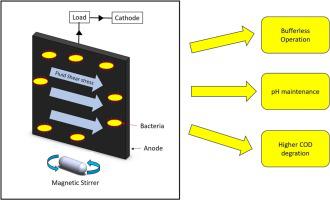当前位置:
X-MOL 学术
›
Process Biochem.
›
论文详情
Our official English website, www.x-mol.net, welcomes your feedback! (Note: you will need to create a separate account there.)
Flow Shear Stress applied in Self-Buffered Microbial Fuel Cells
Process Biochemistry ( IF 4.4 ) Pub Date : 2020-12-01 , DOI: 10.1016/j.procbio.2020.09.017 Chin-Tsan Wang , Raymond Chong Ong Tang , Men-Wei Wu , Akhil Garg , Aristotle T. Ubando , Alvin Culaba , Hwai-Chyuan Ong , Wen-Tong Chong
Process Biochemistry ( IF 4.4 ) Pub Date : 2020-12-01 , DOI: 10.1016/j.procbio.2020.09.017 Chin-Tsan Wang , Raymond Chong Ong Tang , Men-Wei Wu , Akhil Garg , Aristotle T. Ubando , Alvin Culaba , Hwai-Chyuan Ong , Wen-Tong Chong

|
Abstract The development of renewable and clean energy has been the priority of the global research field due to the urgent effects of climate change. Microbial fuel cell (MFC) is recognized as a sustainable approach to simultaneously generate power and treat wastewater through the employment of microorganisms as catalyst. The use of buffer solution in the wastewater treatment makes the commercial application of MFCs challenging due to their environmental impact and high costs. This work uses rotational motion to generate the flow stress in the anode chamber of the MFCs to enhance biofilm growth and mass transfer that leads to an overall performance improvement of the system. The effects on pH, chemical oxygen demand (COD), and power density were evaluated under rotational speeds of the magnetic stirrer from 0 to 640 rpm. The influence of the stirrer was then assessed utilizing the same parameters specified for scenarios with and without buffer. The results reveal that at 480 rpm of stirring speed, the pH value was neutral with a maximum COD removal of 82 % for bufferless and 93 % for buffered scenarios. In addition, for bufferless operation at 480 rpm yielded a power density of 402 mWm−2. The results of the flow stress analysis for bufferless and buffered MFCs are beneficial for the commercialization and future development of the system for wastewater treatment applications.
中文翻译:

自缓冲微生物燃料电池中的流动剪切应力
摘要 由于气候变化的紧迫性,可再生清洁能源的开发已成为全球研究领域的重点。微生物燃料电池 (MFC) 被公认为是一种通过使用微生物作为催化剂同时发电和处理废水的可持续方法。由于其环境影响和高成本,在废水处理中使用缓冲溶液使得 MFC 的商业应用具有挑战性。这项工作使用旋转运动在 MFC 的阳极室中产生流动应力,以增强生物膜的生长和传质,从而提高系统的整体性能。在 0 至 640 rpm 的磁力搅拌器转速下评估对 pH、化学需氧量 (COD) 和功率密度的影响。然后使用为有和没有缓冲的情况指定的相同参数评估搅拌器的影响。结果表明,在 480 rpm 的搅拌速度下,pH 值为中性,无缓冲的最大 COD 去除率为 82%,缓冲方案为 93%。此外,对于 480 rpm 的无缓冲运行,产生了 402 mWm-2 的功率密度。无缓冲和缓冲 MFC 的流动应力分析结果有利于废水处理应用系统的商业化和未来发展。对于 480 rpm 的无缓冲运行,产生了 402 mWm-2 的功率密度。无缓冲和缓冲 MFC 的流动应力分析结果有利于废水处理应用系统的商业化和未来发展。对于 480 rpm 的无缓冲运行,产生了 402 mWm-2 的功率密度。无缓冲和缓冲 MFC 的流动应力分析结果有利于废水处理应用系统的商业化和未来发展。
更新日期:2020-12-01
中文翻译:

自缓冲微生物燃料电池中的流动剪切应力
摘要 由于气候变化的紧迫性,可再生清洁能源的开发已成为全球研究领域的重点。微生物燃料电池 (MFC) 被公认为是一种通过使用微生物作为催化剂同时发电和处理废水的可持续方法。由于其环境影响和高成本,在废水处理中使用缓冲溶液使得 MFC 的商业应用具有挑战性。这项工作使用旋转运动在 MFC 的阳极室中产生流动应力,以增强生物膜的生长和传质,从而提高系统的整体性能。在 0 至 640 rpm 的磁力搅拌器转速下评估对 pH、化学需氧量 (COD) 和功率密度的影响。然后使用为有和没有缓冲的情况指定的相同参数评估搅拌器的影响。结果表明,在 480 rpm 的搅拌速度下,pH 值为中性,无缓冲的最大 COD 去除率为 82%,缓冲方案为 93%。此外,对于 480 rpm 的无缓冲运行,产生了 402 mWm-2 的功率密度。无缓冲和缓冲 MFC 的流动应力分析结果有利于废水处理应用系统的商业化和未来发展。对于 480 rpm 的无缓冲运行,产生了 402 mWm-2 的功率密度。无缓冲和缓冲 MFC 的流动应力分析结果有利于废水处理应用系统的商业化和未来发展。对于 480 rpm 的无缓冲运行,产生了 402 mWm-2 的功率密度。无缓冲和缓冲 MFC 的流动应力分析结果有利于废水处理应用系统的商业化和未来发展。


























 京公网安备 11010802027423号
京公网安备 11010802027423号